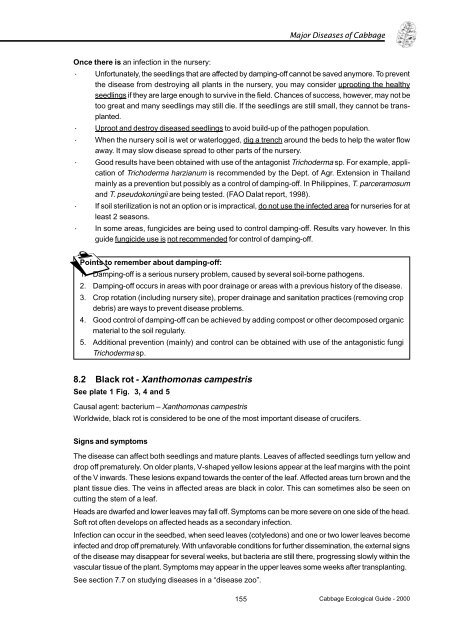Cabbage Integrated Pest Management : An Ecological Guide.
Cabbage Integrated Pest Management : An Ecological Guide.
Cabbage Integrated Pest Management : An Ecological Guide.
Create successful ePaper yourself
Turn your PDF publications into a flip-book with our unique Google optimized e-Paper software.
Major Diseases of <strong>Cabbage</strong>Once there is an infection in the nursery:· Unfortunately, the seedlings that are affected by damping-off cannot be saved anymore. To preventthe disease from destroying all plants in the nursery, you may consider uprooting the healthyseedlings if they are large enough to survive in the field. Chances of success, however, may not betoo great and many seedlings may still die. If the seedlings are still small, they cannot be transplanted.· Uproot and destroy diseased seedlings to avoid build-up of the pathogen population.· When the nursery soil is wet or waterlogged, dig a trench around the beds to help the water flowaway. It may slow disease spread to other parts of the nursery.· Good results have been obtained with use of the antagonist Trichoderma sp. For example, applicationof Trichoderma harzianum is recommended by the Dept. of Agr. Extension in Thailandmainly as a prevention but possibly as a control of damping-off. In Philippines, T. parceramosumand T. pseudokoningii are being tested. (FAO Dalat report, 1998).· If soil sterilization is not an option or is impractical, do not use the infected area for nurseries for atleast 2 seasons.· In some areas, fungicides are being used to control damping-off. Results vary however. In thisguide fungicide use is not recommended for control of damping-off.¤Points to remember about damping-off:1. Damping-off is a serious nursery problem, caused by several soil-borne pathogens.2. Damping-off occurs in areas with poor drainage or areas with a previous history of the disease.3. Crop rotation (including nursery site), proper drainage and sanitation practices (removing cropdebris) are ways to prevent disease problems.4. Good control of damping-off can be achieved by adding compost or other decomposed organicmaterial to the soil regularly.5. Additional prevention (mainly) and control can be obtained with use of the antagonistic fungiTrichoderma sp.8.2 Black rot - Xanthomonas campestrisSee plate 1 Fig. 3, 4 and 5Causal agent: bacterium – Xanthomonas campestrisWorldwide, black rot is considered to be one of the most important disease of crucifers.Signs and symptomsThe disease can affect both seedlings and mature plants. Leaves of affected seedlings turn yellow anddrop off prematurely. On older plants, V-shaped yellow lesions appear at the leaf margins with the pointof the V inwards. These lesions expand towards the center of the leaf. Affected areas turn brown and theplant tissue dies. The veins in affected areas are black in color. This can sometimes also be seen oncutting the stem of a leaf.Heads are dwarfed and lower leaves may fall off. Symptoms can be more severe on one side of the head.Soft rot often develops on affected heads as a secondary infection.Infection can occur in the seedbed, when seed leaves (cotyledons) and one or two lower leaves becomeinfected and drop off prematurely. With unfavorable conditions for further dissemination, the external signsof the disease may disappear for several weeks, but bacteria are still there, progressing slowly within thevascular tissue of the plant. Symptoms may appear in the upper leaves some weeks after transplanting.See section 7.7 on studying diseases in a “disease zoo”.155 <strong>Cabbage</strong> <strong>Ecological</strong> <strong>Guide</strong> - 2000




![Section 4 [ PDF file, 252 KB] - The Field Alliance](https://img.yumpu.com/51387260/1/158x260/section-4-pdf-file-252-kb-the-field-alliance.jpg?quality=85)











